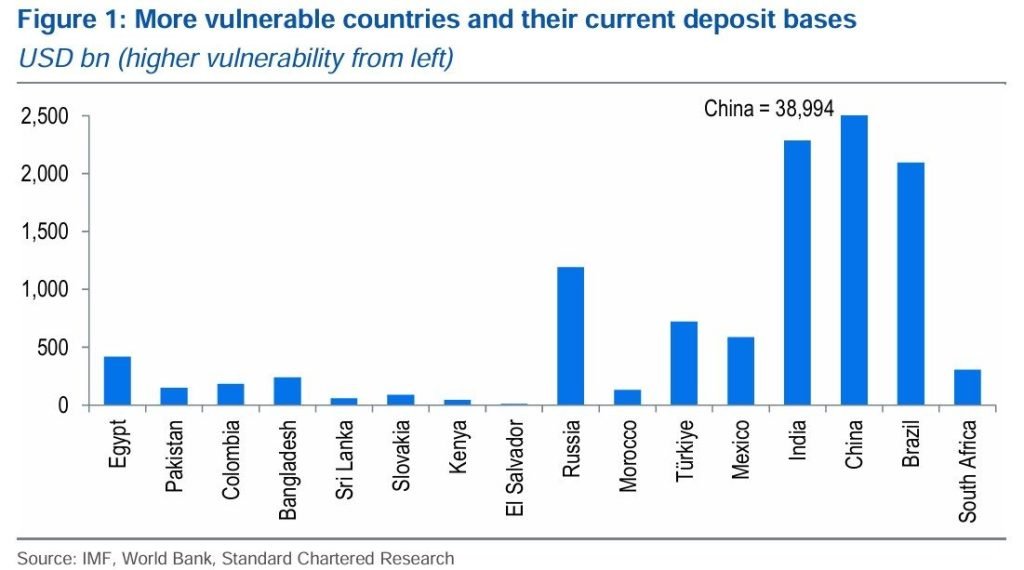Standard Chartered has warned that over $1 trillion could flow out of emerging-market (EM) banks and into stablecoins by 2028, as adoption of dollar-pegged crypto assets accelerates globally.
In a report published Monday, the bank’s Global Research unit said growing adoption of stablecoins could trigger one of the largest structural shifts in modern banking, diverting savings from traditional lenders to blockchain-based alternatives.
The report estimates that stablecoin holdings in emerging markets could rise from $173 billion today to $1.22 trillion within three years, implying a potential $1 trillion drain from EM banking systems.
As Inflation Rises, Stablecoins Fill the Banking Gap Across the Global South
According to the bank’s global head of digital asset research, Geoffrey Kendrick, and economist Madhur Jha, stablecoins have effectively become “USD-based bank accounts” for millions in regions with limited access to U.S. dollars.
They noted that adoption is spreading from a few large holders to a much wider base of small-scale users seeking liquidity, reliability, and 24/7 access, features often missing in traditional banking.
Standard Chartered identified Egypt, Pakistan, Colombia, Bangladesh, and Sri Lanka as the most exposed to a potential deposit flight, with Turkey, India, China, Brazil, South Africa, and Kenya also at risk.
Stablecoins such as Tether’s USDT and Circle’s USDC, digital assets pegged 1:1 to the U.S. dollar and backed by cash or short-term Treasurys, have become essential in economies suffering from high inflation and weak local currencies.
In Venezuela, where inflation has risen as high as 300%, stablecoins have effectively replaced the national currency in everyday use. Merchants frequently price goods in USDT, locally known as “Binance dollars.”
According to Chainalysis, Venezuela ranked 13th globally for crypto adoption in 2024, with usage up 110% year-over-year. Crypto also accounted for around 9% of the country’s $5.4 billion in remittances.
Similar patterns have emerged in Argentina and Brazil, where stablecoins now make up roughly 60% of crypto transactions, according to Fireblocks. Businesses in both countries increasingly turn to USDC and USDT to hedge against inflation and currency instability.
The report also addresses the U.S. GENIUS Act, passed earlier this year, which bans U.S.-compliant stablecoin issuers from offering yield. Despite this, Standard Chartered expects adoption to continue rising, arguing that “return of capital matters more than return on capital.”
The bank projects the global stablecoin market could reach $2 trillion by the end of 2028, aligning with forecasts cited by the U.S. Treasury.
However, the bank warned that emerging markets will feel the most pressure, as stablecoin migration could limit banks’ ability to fund loans and weaken the traditional link between deposits and credit creation.
Emerging Markets Drive Stablecoin Boom, Holding Two-Thirds of Supply
This concern is echoed in traditional finance circles. On October 1, Bank of England Governor Andrew Bailey warned that stablecoins could “reshape Britain’s financial system” by separating the holding of money from credit provision.
He said such a change could reduce the role of commercial banks in lending and potentially destabilize the financial system.
The Bank of England is preparing a consultation paper on its systemic stablecoin framework, proposing limits between £10,000 and £20,000 for people and £10 million for businesses.
Officials say the measure seeks to slow potential outflows from bank deposits, though it has drawn criticism from crypto advocates.
Coinbase’s vice president of international policy, Tom Duff Gordon, said caps would be “bad for UK savers” and restrict innovation. The Payments Association similarly argued that ownership limits are unnecessary and difficult to enforce.
In the private sector, major firms are urging banks to adapt. Stripe CEO Patrick Collison said the rise of stablecoins will likely force banks to increase deposit yields. “Being so consumer-hostile feels like a losing position,” he wrote on X, noting that savings accounts pay just 0.40% in the U.S. and 0.25% in the EU.
The tension between traditional banking and stablecoins has intensified since the GENIUS Act established a U.S. framework for regulated issuance. Coinbase has challenged claims that stablecoins threaten banking stability, calling the “deposit erosion” narrative overstated.
The exchange noted that banks earn about $176 billion annually from Federal Reserve reserves while paying minimal returns to customers.
Standard Chartered’s report concludes that stablecoin adoption in emerging markets is no longer a fringe trend but a systemic shift already underway.
With two-thirds of today’s stablecoin supply held in savings wallets across developing economies, the bank warns that the next few years could see a historic transfer of capital from traditional banks to digital dollar alternatives.
The post Banking Giant Issues Dire Warning: Stablecoins Could Drain $1 Trillion From Global Banks by 2028 appeared first on Cryptonews.

 The Chainalysis 2025 Global Crypto Adoption Index is out: India ranks #1, the United States #2
The Chainalysis 2025 Global Crypto Adoption Index is out: India ranks #1, the United States #2 Bank of England Governor says stablecoins could reduce UK reliance on commercial banks while proposing controversial ownership caps.
Bank of England Governor says stablecoins could reduce UK reliance on commercial banks while proposing controversial ownership caps.
 Coinbase published a defense against banking claims that stablecoins threaten financial stability, calling the "deposit erosion" narrative a "myth" protecting banks' $187 billion monopoly.
Coinbase published a defense against banking claims that stablecoins threaten financial stability, calling the "deposit erosion" narrative a "myth" protecting banks' $187 billion monopoly.